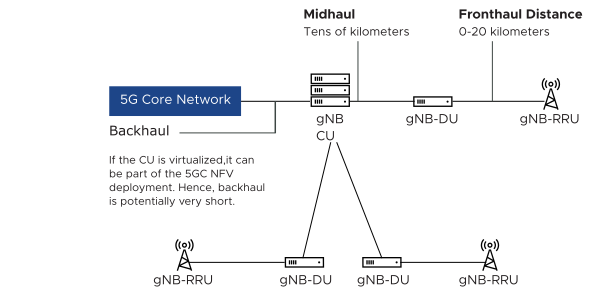In RAN virtualization, the relocation of baseband radio functions from custom-built nodes to vendor-agnostic Commercial Off-the-Shelf (COTS) hardware.
In 3GPP R15, the division of the upper and lower sections of the RAN was standardized. The higher-layer split is specified with a well-defined interface (F1) between the Centralized Unit (gNB-CU) and the Distributed Unit (gNB-DU). The CU and its functions, which are similar to the radio, have less stringent processing specifications and are more virtualization-friendly than the DU and its functions. The enhanced Common Public Radio Interface (eCPRI) links the DU to the radio.
The benefits of a fully virtualized RAN (vRAN) are as follows:
-
A single uniform hardware platform is used across the core network, RAN, and edge. This simplifies network management while lowering operational and maintenance costs.
-
The network functions and computing hardware are isolated in a completely virtualized RAN. The network functions of the RAN can be performed on the same hardware, giving the service provider more versatility. The functionality and capacity of a vRAN can be easily implemented where and when it is required, giving it more flexibility.
The following figure shows vRAN (also called Centralized RAN) and the terminologies that are used to define various legs of the transport network:

-
Centralized Unit (CU) provides non-real-time processing and access control. It manages higher layer protocols including Radio Resource Control (RRC) from the Control Plane, and Service Data Adaptation Protocol (SDAP) and Packed Data Convergence Protocol (PDCP) from the User Plane. The CU is connected between the 5G core network and the DUs. One CU can be connected to multiple DUs.
-
Distributed Unit (DU) provides real-time processing and coordinates lower layer protocols including Physical Layer, Radio Link Control (RLC ), and Media Access Control (MAC).
-
Remote Radio Unit (RRU) does the physical layer transmission and reception, supporting technologies such as Multiple Input Multiple Output (MIMO).
vRAN Design Approaches
The different design approaches of vRAN are as follows:
Co-located CU and DU:
A non-centralized approach utilizes the CU and DU functions co-located, with RRU physically separated.
Only fronthaul and backhaul connectivity is required in this design.

Centralized Processing:
In the centralized approach, all functional elements of the gNB are physically separated. A single CU is responsible for several DUs. The design requirements of the Next-Generation RAN (NG-RAN) require specific transport network specifications to meet the required distances. This design model requires fronthaul, midhaul, and backhaul connectivity.

DU and RRU Co-Located:
In this vRAN design approach, the DU and RRU are co-located such that they are directly connected without a fronthaul transport network. This connection is fiber-based and may span hundreds of meters, supporting scenarios where the DU and RRU are within the same building. This design approach requires midhaul and backhaul connectivity as shown in the following figure.

The centralized CU vRAN design introduces several advantages:
-
Cost Reduction: Centralized processing capability reduces the cost of the DU function.
-
Energy Efficiency, Power and Cost Reduction: Reducing the hardware in the cell site, reduces the power consumption and air conditioning of that site. The cost saving can be significant when you deploy tens or hundreds of cell sites.
-
Flexibility: Flexible hardware deployment leads to a highly scalable and cost-effective RAN solution. Also, the functional split of the protocol stack has an effect on the transport network.
-
Higher Performance: Better performance is achieved as a result of improved load management, cell coordination, and the future deployment of Radio interference mitigation algorithms.
-
Improved offload and content delivery: Aggregation of processing at the CU provides an optimal place in the network for data offload and MEC application delivery.